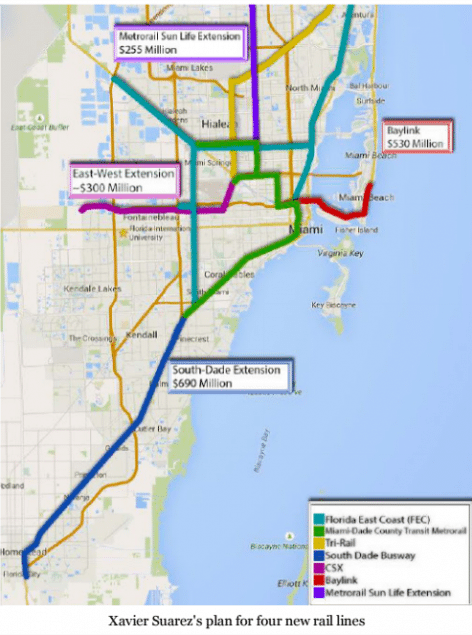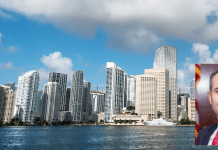To understand what is happening in Miami-Dade County mass transportation, one needs to understand what is really the substantive consensus among those in a position to actually effectuate reform. Here is what has been accomplished by a coalition of the County, legislative, and city leaders, aided by the wisdom of Paul Schwiep and Citizens’ Transportation Trust.
1. Metrorail Expansion. Consensus has been achieved by all parties on four mass-transit linkages: Baylink to the East, CSX connector to the West, elevated light-rail along the Busway to the Southwest and elevated light-rail along NW 27th avenue to Sun Life Stadium.
2. Cost of the Metrorail Expansion. Consensus has been achieved as to the cost of the above four linkages, with estimates all in the range of $2 billion dollars. Consensus has also been achieved that wherever there is an existing rail, at-grade “streetcars” are not only the most economical system, but also the most attractive vehicles to change the mentality of the typical middle-class commuter, who will not feel comfortable riding an enormous bus that often comes late and has to stop at every street light.
3. Tri-County Connectivity. Thanks in particular to the diplomatic skills of Miami Commissioner Francis Suarez, and of the district commissioner Audrey Edmonson, we now have Tri-rail linked to downtown Miami. In the near future, using the same formula (perpetual easement), we can count on a commuter train (“Coastal Link”) connecting Miami to Ft. Lauderdale and Palm Beach, sharing at least 63 of the 81 miles of FEC passenger rail along the I-95 corridors, potentially serving 28 population clusters. South Florida, at that point in the near future, will have solved its I-95 corridor nightmare with affordable mass-transit. Commissioner Sally Heyman is an avid proponent of this link, which will serve – among others – Aventura. North Miami Beach Mayor George Vallejo and North Miami Mayor Smith Joseph are both enthusiastic supporters of having train stops in the core of their cities.
4. Baylink – Connecting Downtown Miami to Miami Beach. Baylink, which has languished in the planning stages for three decades, is now a feasible reality. Thanks to a compromise reached at the recent Executive Policy Committee, the two participating cities (Miami and Miami Beach) will be allowed to proceed with design, environmental studies and funding efforts, while the state and county file a federal National Environmental Policy Act application that will make the integrated system eligible for federal funds. Commissioner Bruno Barreiro, in addition the mayors of the two cities and the county, supported unanimously the wording change I proposed that gives the state until August 15, 2016, to complete the federal Fast Start Application – else the cities are allowed to “proceed independently.”
5. CSX Line – East/West Mass Transit Solution. Consensus has been reached, under the leadership of Mobility and Transportation Chairman, Esteban Bovo, that the CSX line should be acquired for passenger rail use. Chair Bovo and Commissioner Francis Suarez (who is also Metropolitan Planning Organization vice-chair and incoming president of the Miami-Dade League of Cities, recently traveled to Tallahassee seeking state funds for that acquisition.) Commissioners Juan Zapata and “Pepe” Diaz have been advocating that linkage for some time now.
6. Metrorail Expansion South to Homestead. Consensus has been reached, under the leadership of Representative Kionne McGhee and the unanimous support of mayors along the Dadeland-to-Florida City Busway, for an elevated rail system. (At the Homestead Council meeting in which I made the presentation with Rep. McGhee, we received enthusiastic testimony from mayors Wallace, Porter, Bell, Stoddard, Flinn, and – representing Mayor Lerner – Vice-Chair Jim McDonald. Also present and supporting the concept was Congressman Carlos Curbelo, who recently voted with his colleagues from Miami-Dade, for a $200 billion appropriation for transit initiatives.)
7. 27th Avenue Transit Solution. Consensus has been reached, under the leadership of Commissioner Barbara Jordan, that the mass-transit link along NW 27th Avenue should be elevated light-rail. As discussed in the Sunshine Meeting I convened with Daniella Levine-Cava, Bus Rapid Transit (BRT) is not discarded but only as a temporary solution. See, in that connection, my comment at paragraph 10 below.
8. MPO Subcommittee Consensus. At a meeting convened by Transit Solutions Chairman Dennis Moss, and attended by Funding and Priorities Chairwoman Daniella Levine-Cava, as well as Senator Oscar Braynon and Representatives Erik Fresen and Jose Javier Rodriguez, a letter of support for my 25/5 plan, submitted by Delegation Chair, Senator Anitere Flores, was introduced into the record and is attached hereto. It represents a consensus of our county’s legislators in support of using as much of the Miami-Dade Expressway Authority (MDX) excess revenues and as much of the auto-tag renewal fees as politically feasible to fund the four mass-transit links. During the hearing, North Miami Mayor Smith Joseph asked how I would propose funding the gap in my overall funding plan created by the postponement of the PTP funds for 3-5 years hence. My answer was that it could be done in various ways that produce about $50 million a year: Either state or federal funds or by phasing-in the PTP funds during the design and environmental phases of the four projects, which take an average of three years to complete. I also mentioned that $50 million is 1% of the county’s operating budget, and that the county should do as the City of Miami has done (under the leadership of Commissioner Suarez) and start earmarking a percentage of our general and enterprise revenues to mass transit.
9. Bipartisan Accord. Lost in the discussion of transit initiatives is perhaps the most important consensus that has been achieved, given the county commission’s ideological split that gives us an exact, even breakdown of Republicans and Democrats. Two Republican commissioners, Rebeca Sosa and Esteban Bovo, have pronounced themselves, in a Sunshine Meeting, to be supportive of the idea that we must stop building highways (as MDX wants to continue doing) as a solution to our transit woes. Commissioner Javier Souto has long been an advocate of neighborhood circulators and other alternatives to the automobile. (Newly installed Transportation Department director Alice Bravo refers to this mindset as leading to a “car optional community.”)
10. Moving Away From Buses. In committee and Sunshine meetings with Commissioners Levine and Jordan, I have argued that BRT solutions are not the ideal transit solution, for every reason imaginable. However, due to the county’s commitment to large buses and the MDX ample resources, I have accepted the idea as a transitional solution along both the Busway and NW 27th Avenue. In recent testimony before the Moss committee, I even suggested that once the roadway improvements are made, even with elevated light rail is installed, smaller buses or trolleys could use the extra lanes and mass-transit stops, if it is found that they help automobile traffic, rather than impede the normal flow. Again, the idea is to foster consensus in both the short-run and long-run, so as not to delay the ultimate solution of a viable system of mass-transit.
In sum, a new era is approaching which will leave us with six, viable branches of a rail system, where now only two short ones exist. Interestingly, a former Herald reporter, John Dorschner, has been covering some of the latest, rather momentous hearings. His most recent account of the above-mentioned Transit Solutions Committee (the Moss committee) meeting is attached for your consideration.
For more information, contact Miami-Dade County Commissioner Xavier L. Suarez at 305-669-4003 or via email at district7@miamidade.gov.







